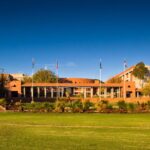Understanding the story behind the buildings we all take for granted has won a Curtin architecture lecturer a prestigious national teaching award.

“I reckon stories is where you go,” says Khoa Do who recently received an Australian Learning and Teaching Council citation for his unique, innovative teaching approach.
To illustrate his point, Dr Do points to Curtin’s much-maligned Architecture and Planning building that was erected along now-unfashionable Brutalist principles.
“Everyone hates it, but it’s great,” he says.
“It presents lots of opportunities, especially for teaching.”
Dr Do says the concrete and brick structure was built in an international style but lots of thought went into tailoring it to local needs.
“The story behind this building was that (with) the central atrium space, the architect took it from a street market,” he says.
“The studios down on that level would spill out and it could be turned into a formal gallery where you pin up (students’) work.
“Then, on a kind of market day, students and staff would overflow to this central space.”
Dr Do says the latent energy of the building starts flowing when School of Built Environment students run ‘kinetic’ experiments where one project transfers energy to the next, invariably resulting in some kind of explosion at the end.
“The whole building comes alive,” he says.
“It’s a stage.”
Even the building’s stark concrete staircases have a role to play in connecting students to activities.
“Utilitarianly, you can see (the staircases) as access, but they are actually like Juliette balconies – you look over and become part of it,” Dr Do explains.
He says that teaching story-based analytical techniques to students helps them make sense of the wider world of architecture.
“You’ve got individual memory and you’ve got the collective memory, and the significance of that memory is something that needs to be appreciated by designers,” he says.
“The idea of timeless architecture is something I don’t believe we engender in design any more.”
Balancing timeless design with the demands of rapidly changing cities is a challenge that Curtin students grapple with during the ‘global studio’ field trips Dr Do occasionally runs with architecture professor John Stephens.
“We’ve travelled to Vietnam, Malaysia, Hong Kong, China,” Dr Do says of the program that sees up to 50 Curtin architecture students experience a foreign city at any one time.
“We tee up with the universities over there to do mini-conferences, to get the students to actually do a conference to present their work.”
He says that preconceived ideas about the host city quickly evaporate when the Curtin students start swapping ideas with their counterparts abroad.
“All the assumptions, say about Vietnam being a war torn country, get quickly dispelled,” he says.
“The students are repositioned and think, ‘wow, now my project is gone’, but no, it’s not gone, you need to appreciate the story.
“You can’t presume – every day a city changes.”
On the flipside, the Curtin students help broaden the architectural focus of the host students.
“The local students can get complacent and take their city for granted,” Dr Do says.
“Our students suggest that maybe you need to take account of what visitors are telling you and re-evaluate how you see things.”


